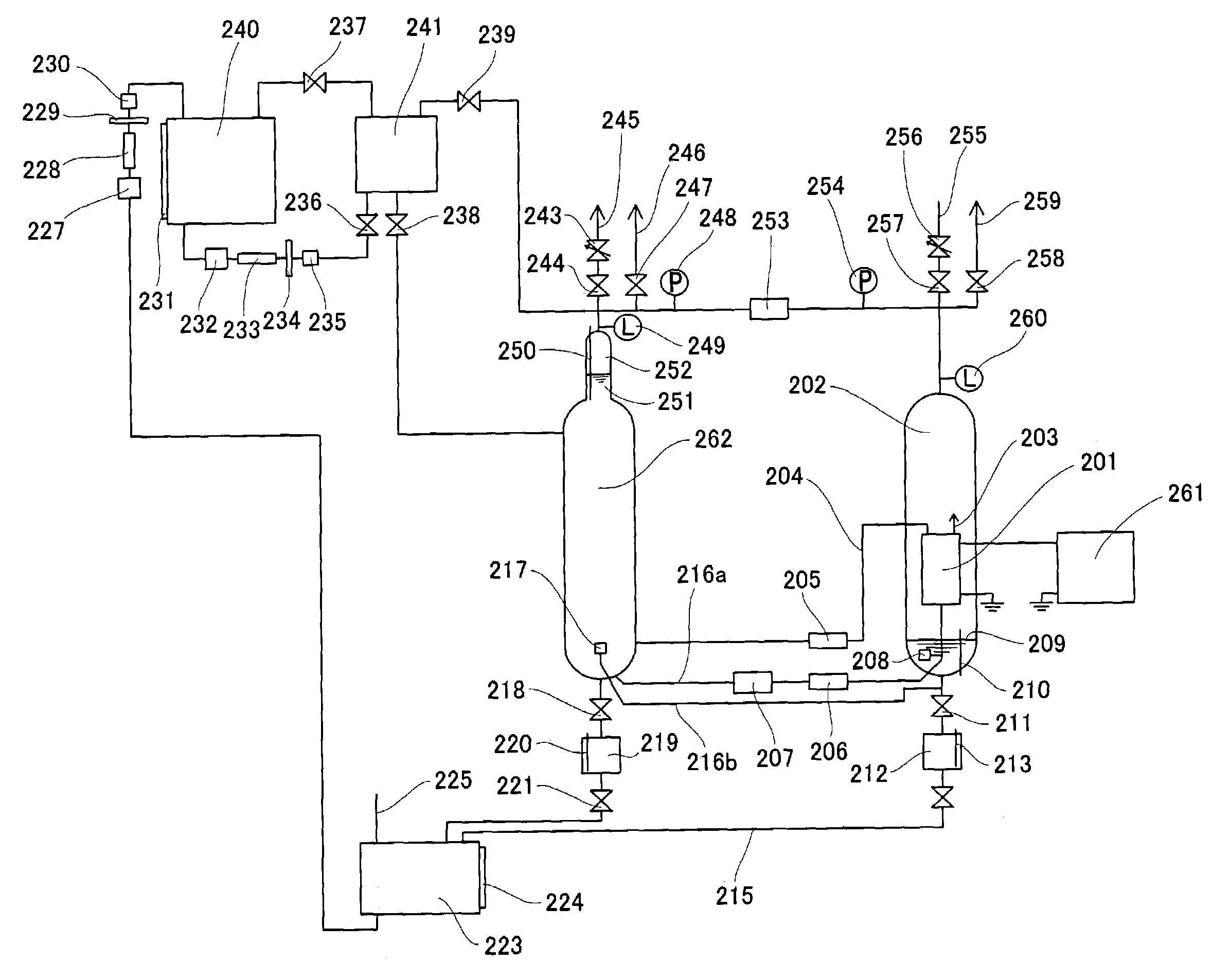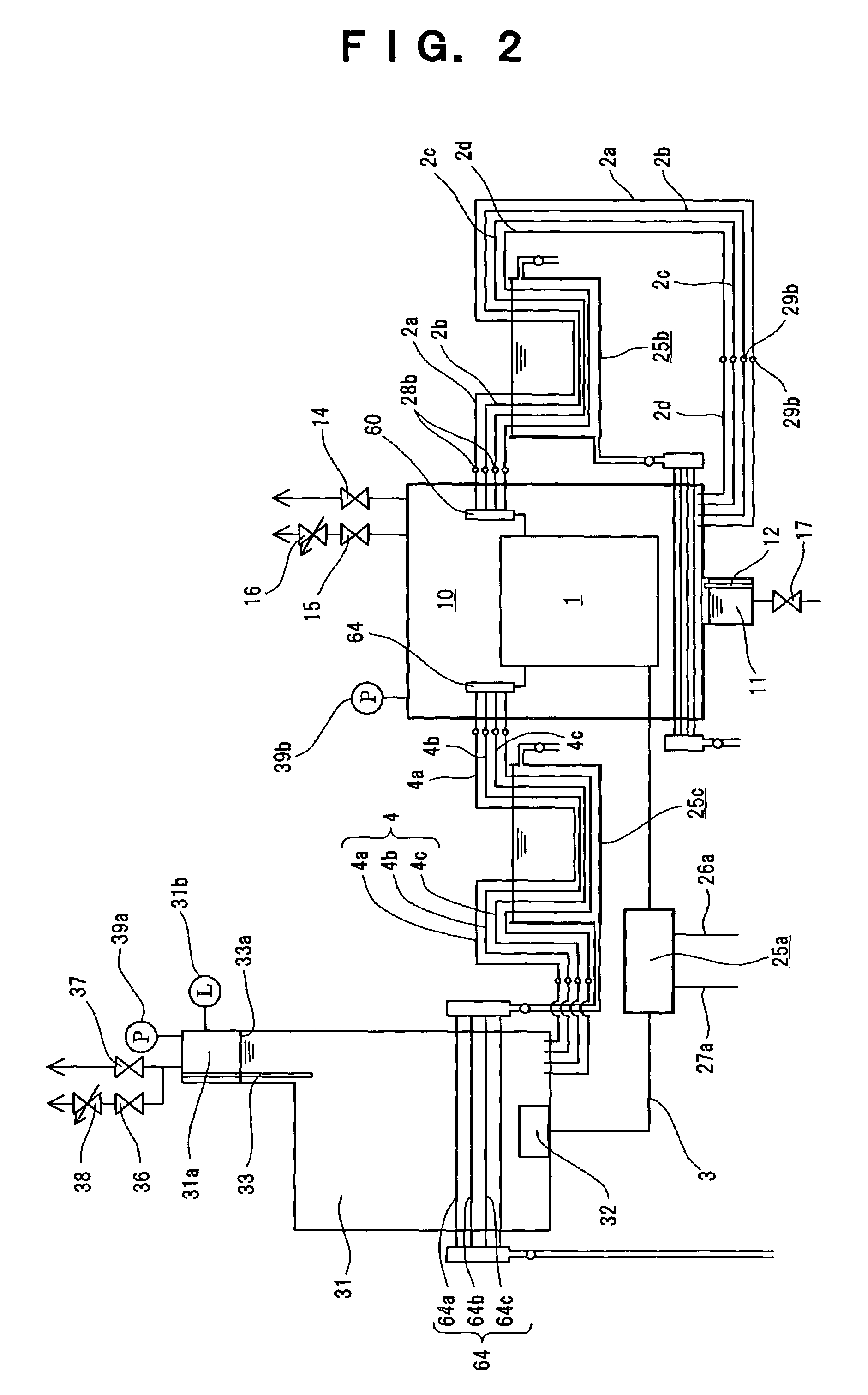Furthermore, there exist fundamental problems that the estimated amount of
fossil fuel deposits is limited, and they may be depleted sooner or later.
However, batteries are heavy, and the charge is consumed by self-
discharge during storage while it is not used.
The most crucial problem for the future energy is to be free from the problems as described above, or the energy should be easily stored and transported while being able to be commonly used where and when necessary.
The most important problem for utilizing hydrogen as the
energy source is how hydrogen gas could be safely transported and stored in a compact vessel.
However, these methods involve unsolvable problems of spontaneous
evaporation and insufficient
occlusion volume.
When the volume of the hydrogen
gas cylinder is small, on the other hand, the cruising distance is so shortened that it is impractical.
Consequently, the
mixed gas becomes a detonating gas that involves a danger of explosion making it difficult to arbitrarily stop and start gas generation.
It is not easy to generate hydrogen by electrolysis of the aqueous alkaline solution using
electric power generated by
sunlight or aerodynamic power that frequently varies.
Furthermore, since the pressure of hydrogen generated by electrolysis of the aqueous alkaline solution is low, use of a
gas compressor is required in order to prepare a highly
compressed hydrogen.
However, it is a current problem of electrolysis by electrolysis cell using PEM that the
pressure resistance of the seal member and PEM of the electrolysis cell is as low as about 4 atm.
Moreover the liquefier needs regular or frequent maintenance, and is hard to produce
liquid hydrogen at a
remote area under automatic operation with a shortage of hands.
An amount of energy exceeding the amount of hydrogen energy currently available in the market may be consumed as the energy required for liquefying such a vast amount of hydrogen.
Although enough liquefying machines for liquefying such a vast amount of hydrogen should be constructed, the additionally constructed liquefying machines only consume energy without creating additional energy.
Therefore, use of liquefied hydrogen as an
energy source is disadvantageous with respect to the
energy conversion efficiency, and facilities that do not create additional energy are forced to be constructed to realize the use of liquefied hydrogen.
The
gas compressor involves, on the other hand, the problems of wear of parts as described previously.
Devices with satisfactory functions are not available today.
There are no gas compressors with a capacity of 300 N / m3 and
contamination of hydrogen by the
gas compressor itself is another problem that cannot be ignored.
When the purity of hydrogen used as the fuel for converting hydrogen into electric power using the PEM fuel cell is poor, the electrodes are poisoned and decrease the output power of the cell, shortening the service life of the cell.
However,
corrosion of metallic parts should be considered in the device for generating the hydrogen and
oxygen gases.
Therefore, the electrolysis cell having the electrodes is sealed in an environment containing
high pressure oxygen, that readily causes
corrosion of metals, and water together as the pressure is increased.
Furthermore,
corrosion of the metallic parts, such as the electrodes, are liable to occur as the temperature is increased in the permissible range of
heat resistance of PEM.
In addition, the leak current cannot be ignored since the resistivity of pure water in which the PEM electrolysis cell is submerged decreases.
When the problem of temperature increase is solved by cooling pure water in which the PEM electrolysis cell is submerged by using a
heat exchanger, the cell is forced to be operated at a temperature of 40° C. or less where the cell efficiency becomes poor, and the operating condition is disadvantageous for effective utilization of heat.
When abnormalities, such as a break of PEM isolating the
anode compartment of the electrolysis cell from its
cathode compartment, or a break of the seal member of the electrolysis cell occur, a large amount of hydrogen is mixed with
oxygen in the
high pressure cell housing the electrolysis cell, arising a danger of generating a detonating gas.
Accordingly, while the generation of
high pressure hydrogen with a pressure of as high as several hundreds of atm or more is possible in principle in this device for generating hydrogen and
oxygen, the device is currently only applicable for generating hydrogen with a pressure of several tens of atm, and it is not easy to generate
high pressure hydrogen with a pressure of several hundreds atm that is considered necessary for utilizing hydrogen as an energy source.
A part of the
electric current flowing in the electrolysis cell flows in pure water in which the electrolysis cell is submerged by the decrease of resistivity of pure water, even when the problem of corrosion of metals is solved, thereby decreasing electrolysis efficiency due to electric
power loss.
In particular, this is a serious problem because the electrolysis efficiency is enhanced by increasing the temperature to about 80° C. or more.
Consequently, it was difficult to generate high pressure hydrogen required for utilization of hydrogen as a energy source.
However, this method is still difficult to practically employ since no practically available electrically insulating liquid for immersing the electrolysis cell in the high
pressure vessel has not been found yet.
A vast quantity of electrically insulating liquid is needed for covering the demands of the device for generating enough hydrogen to be converted into the vast amount of energy that is supposed to be consumed.
However, it is difficult to chemically synthesize and use a large quantity of the electrically insulating liquid without any burden to the environment, or so that the environment, particularly
groundwater and soil, is not readily polluted by leakage.
For example, although PCB is a
flame-retarded liquid with excellent performances, its production and use are forbidden from the view point of public
hazard and environmental
pollution.
Therefore, all the currently available insulating oils are inflammable, and involve a potential danger of explosion when oxygen is leaked.
In addition, pure water is difficult to use since the resistivity of pure water changes with time, as described above, although pure water itself is excellent as a insulating liquid.
This decrease of resistivity not only decreases efficiency of the cell due to a leak
electric current generated, but also hydrogen and oxygen are generated by the leak electric power in the high
pressure vessel housing the electrolysis cell increasing the pressure.
This increase of the pressure may cause a potential danger by which the electrolysis cell may be finally crushed by the pressure, or the
mixed gas of hydrogen and oxygen may explode.
 Login to View More
Login to View More 


